Zucchinis covered in insects, flowers with bite marks, stems with grubs, and holes in the zucchini plant leaves? It sounds like your zucchini plant has a pest problem! And if left untreated, ravenous pests can soon wreak havoc on your zucchini harvest. So if you are wondering what’s eating your zucchini, you’re in the right place.
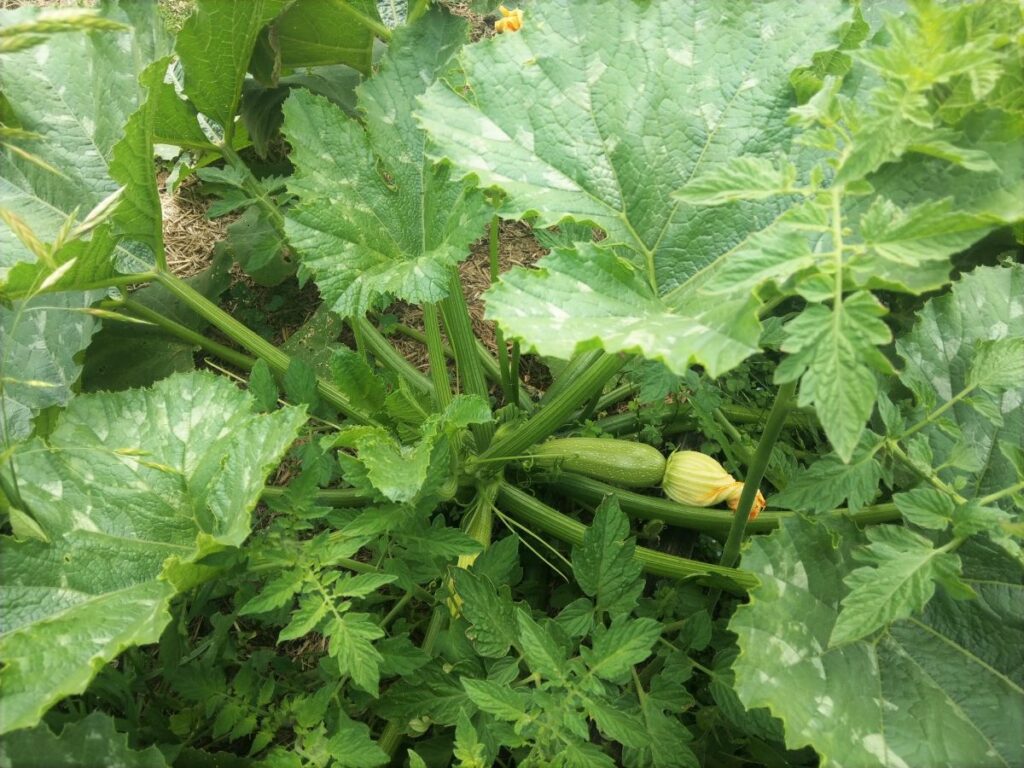
Table of Contents
- What’s Eating My Zucchini?
- Detecting Pests on Zucchini
- 1. Aphids Attacking Zucchini Plants
- 2. Flea Beetles Eating Zucchini Leaves
- 3. Cutworms Eating Zucchini Plants
- 4. Cucumber Beetles Eating Zucchini Leaves
- 5. Beet Armyworms Eating Zucchini
- 6. Cabbage Loopers Eating Zucchini Plants
- 7. Squash Bugs Eating Zucchini Plants
- 8. Squash Vine Borers Eating Zucchini Stems
- 9. Leafminers Eating Zucchini Plants
- 10. Thrips Are Eating Zucchini Plants
- 11. Whiteflies Attacking Zucchini Plants
- Zucchini Plant Natural Predators and Beneficial Insects for Pest Control
- Zucchini Plant Pest Prevention Tips
- Is It Really a Zucchini Pest Problem?
What’s Eating My Zucchini?
The most common pests eating your zucchini are aphids, flea beetles, cutworms, cucumber beetles, beet armyworms, cabbage loopers, squash bugs, squash vine borers, leafminers, thrips, and whiteflies.
Related: Zucchini Plant Flowering But Not Producing | Why Are My Zucchinis So Small? | How To Fix Bitter Zucchini
Detecting Pests on Zucchini
First let me tell you about one summer, when my garden became the stage for an epic battle between my zucchinis and a host of notorious pests. Many of the pests I cover in this article: aphids, flea beetles, cutworms, and squash bugs. But over the years I’ve dealt with them all.
These pests were determined to turn my zucchini plants into a one-stop all-you-can-eat buffet. So I put my Sherlock Holmes thinking hat on and became the garden’s resident sleuth. Each day I investigated the crime scene, checking for clues on holey zucchini leaves, suspicious-looking stems and munched on zucchini fruit.
My sleuthing skills paid off and armed with the knowledge of my enemies’ habits and hideouts, I was able to outsmart them with an organic multi-strategy approach.
I encouraged natural predators, like ladybugs, to keep the aphids in check, and used neem oil for flea beetles while diatomaceous earth helped interrupt their life cycle as well as being a deterrent for the cutworms. While strategically placed decoy plants distracted the squash bugs.
It might seem like a quirky detective story, but in the end, my zucchinis thrived, proving a little detective work can go a long way in outsmarting even the trickiest of garden pests!
Now let’s find out more details about each zucchini pest with solutions to get rid of them using organic gardening methods.
1. Aphids Attacking Zucchini Plants
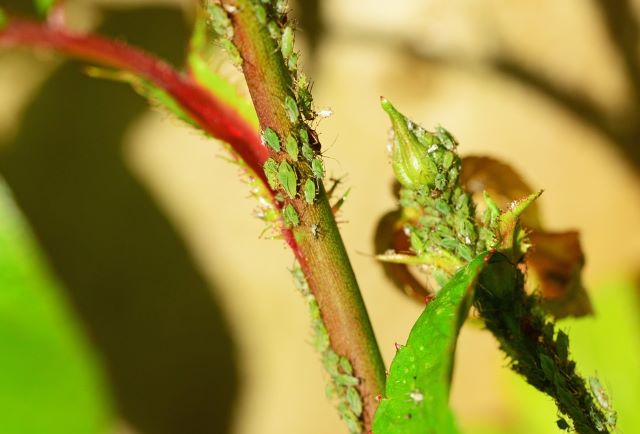
Aphids are the most common garden pest that could be eating your zucchini plant. These small, sap-sucking, soft-bodied insects get a bad rap from home gardeners everywhere, and for good reason!
As they feed, aphids can cause significant damage to zucchini plants. They pierce the zucchini plant’s tissues and suck out the sugary sap, weakening the plant’s overall health.
The feeding habits of aphids will cause yellowing on the zucchini leaves. This can lead to stunted growth, reduced fruit production, and in severe cases, even the death of the plant – though this is not too common.
Aphids like to group in large numbers on the underside of your zucchini leaves, and stems. Additionally, aphids excrete a sticky substance called honeydew, which can attract other pests like ants and promote the growth of sooty mold.
How to Get Rid of Aphids on Zucchini Plants
Although the sight of this garden menace causes gardeners to heave a sigh, they are surprisingly easy to control. If you spot a group of aphids hanging out on your zucchini, grab the garden hose and give your plant a good, but gentle, blast of water. This will dislodge the minuscule intruders.
Once the aphids have been washed off your plant, spray it with a mixture of 1 tablespoon of dishwashing liquid, mixed with 1 quart (1 liter) of water. Apply this once every 2-3 days for two weeks, then once a week to keep aphids off your zucchinis. For an already mixed spray, you can use this Insecticidal Soap Spray which is safe to use in organic gardens.
2. Flea Beetles Eating Zucchini Leaves
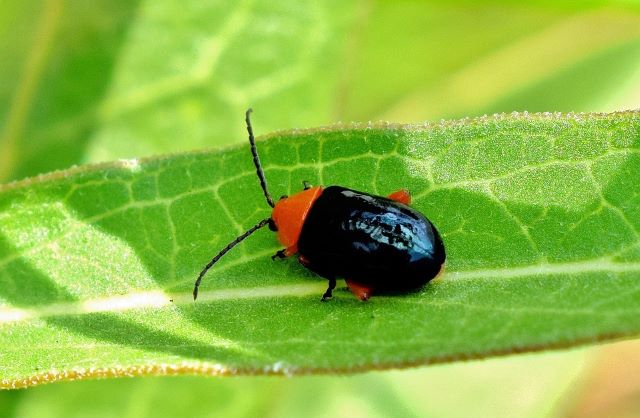
Flea beetles are small, jumping insects that earned their name due to their remarkable ability to jump when disturbed, much like a flea. These tiny pests are usually bronze or black with a metallic sheen.
Flea beetle damage is easy to spot, as they leave small holes in the leaves of your zucchini plants, which are referred to as ‘shotholes.’ In addition to the small holes, if your zucchini is being eaten by flea beetles, your plant’s growth will be stunted. If flea beetles are left unchecked, their feeding habits will eventually kill your zucchini plant.
How to Get Rid of Flea Beetles on Zucchini Plants
To get rid of flea beetles, you will need to spray your zucchini with neem oil. This should be done once every 2-3 days for two weeks, and then once a week thereafter. Once the flea beetles have been removed from your plant, cover them with floating row covers to protect them from future attacks.
In addition, you can spread diatomaceous earth around your plants to stop flea beetles from jumping onto your zucchini.
3. Cutworms Eating Zucchini Plants
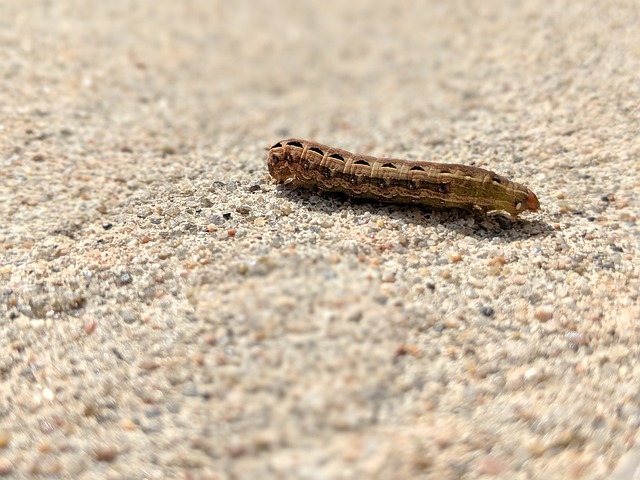
Another pest that could be eating your zucchini plants is cutworms. They are the larvae of various moth species and are known for their habit of “cutting” young zucchini plants at the base, hence their name. Cutworms are usually gray or brown caterpillars.
Cutworms tend to chew through the stems of your zucchini plant, but can also climb and munch on the leaves. If cutworms are eating your zucchini, you will notice irregular holes in the leaves and fruits of your plant as well as potentially cut stems.
How to Get Rid of Cutworms on Zucchini Plants
The first step to getting rid of cutworms is to grab your flashlight and check your zucchini plants when it’s dark. Cutworms are nocturnal and are active at night. Once you spot them, you can easily remove them by hand.
Once you have removed any visible cutworms, you can protect your zucchini by making protective collars out of cardboard, or tinfoil (my personal preference). The collars need to be placed a few inches into the ground around the stem of your plant and reach a few inches above the ground.
Another way to protect your plants from cutworms is by spreading diatomaceous earth around them. I also like to use neem oil on the leaves because this will stop them from laying their eggs.
4. Cucumber Beetles Eating Zucchini Leaves
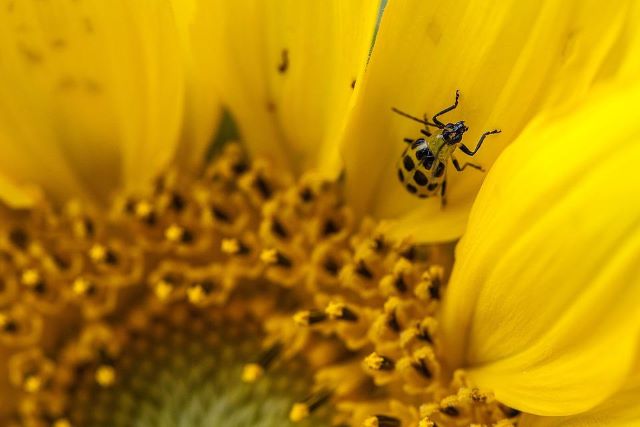
Cucumber beetles are small, oblong-shaped beetles that are known for their distinct yellow-green color and have either black stripes or spots. Cucumber beetles are significant pests in gardens as they can transmit bacterial diseases and cause direct damage to various plants, including zucchinis.
Both striped and spotted cucumber beetles congregate in large numbers on the stems and undersides of your zucchini plant’s leaves. They feed where they group, and can quickly defoliate your zucchini plant.
If cucumber beetles are eating your zucchini, your plant’s growth will be stunted, there will be holes in the leaves, and they will begin to turn yellow.
How to Get Rid of Cucumber Beetles on Zucchini Plants
To get rid of cucumber beetles you will first need to remove them by hand. You can remove them by shaking your zucchini plant. The beetles can be difficult to pick up, so make sure you place a cardboard box underneath your plant.
After you have removed as many of the cucumber beetles as you can, spray your plant with neem oil. You will need to apply the spray every 2-3 days for two weeks, following which you will need to apply it once a week.
5. Beet Armyworms Eating Zucchini
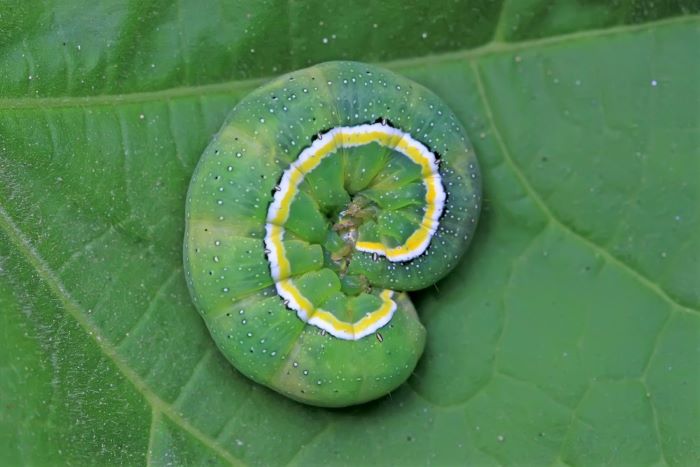
Another caterpillar that could be eating your zucchini is the beet armyworm. These caterpillars are named for their tendency to move through your garden in groups, resembling a miniature army on the move. The moth larvae are typically green or brown with distinct stripes running along their bodies.
Beet armyworms have particularly voracious appetites and can quickly devour your zucchini. If beet armyworms are responsible for your munched zucchini you will notice small, irregularly shaped holes in the leaves. There will also be dry, shallow scars on the fruits.
Be sure to check the underside of your zucchini leaves for egg clusters. The moths lay their eggs in clusters, which are covered in a white substance, giving the clusters a cotton wool appearance.
How to Get Rid of Beet Armyworms from Zucchini Plants
You can remove beet armyworms by hand. If you have caught them at the beginning of their lifecycle, you can control them by applying neem oil to your plants.
Additionally, you can protect your plants from future infestations by covering your zucchini with floating row covers but remember to uncover them for pollination.
6. Cabbage Loopers Eating Zucchini Plants
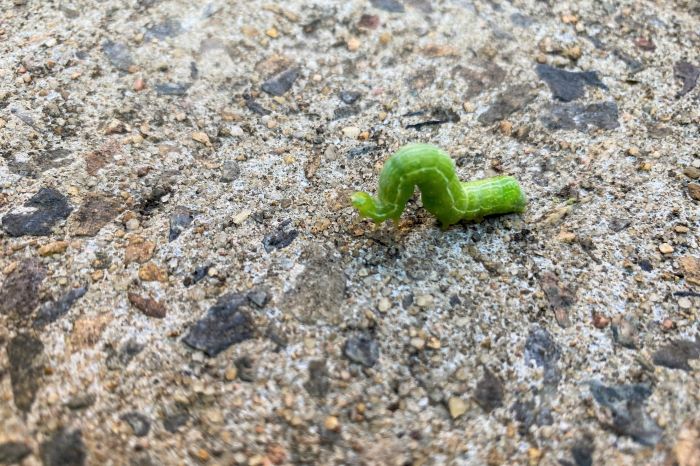
Cabbage loopers are caterpillar pests that get their name from their unique way of moving, which involves looping or arching their bodies as they crawl. Cabbage loopers are the larvae of cabbage looper moths, and are typically green in color, with distinct stripes running along their sides.
If your zucchini is being eaten by cabbage loopers, there will be extensive damage to your plants. You will notice several large and small holes in your zucchini plant’s leaves.
How to Get Rid of Cabbage Loopers from Zucchini
Like the other caterpillars that plague your zucchini plants, the best way to get rid of cabbage loopers, is manually. You can protect your plants from future cabbage looper attacks by covering your plants with the ever-versatile floating row covers.
If your cabbage looper infestation is extensive, you use neem oil. A caterpillar spray could be used as a last resort as these types of sprays, although marketed as safe for organic gardening, still harm our environment.
7. Squash Bugs Eating Zucchini Plants
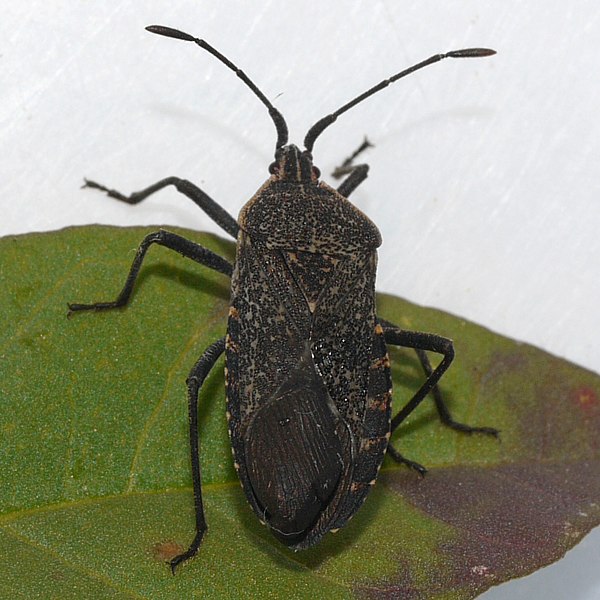
Squash bugs are sap-sucking pests that feed on the sap of zucchini plants by using their piercing mouthparts. Squash bugs are often mistaken for stink bugs because they are similar in appearance.
Squash bugs are typically brownish-gray and have elongated bodies, with distinctive markings on their backs.
They target the leaves, stems, and fruits of squash plants. Their feeding can lead to wilting, yellowing, and the overall decline of the plants. Additionally, squash bugs can transmit diseases that can further harm your zucchinis.
How to Get Rid of Squash Bugs from Zucchini
If you find your pumpkin patch under siege from squash bugs, a daily hand-checking routine is your best defense. Don’t forget to inspect the leaf undersides for those sneaky egg clusters and promptly remove them.
When dealing with squash bugs, tackling them while they’re nymphs is the smart strategy, as the adults tend to play hide-and-seek. Lay down sheets of newspaper around your plants, and these elusive bugs will often seek refuge there. Come morning, simply pluck away any pests you find.
For more extensive infestations, consider the neem oil approach. A blend of directly spraying visible squash bugs and applying neem oil to your pumpkin plant leaves is effective. By coating your plants with neem oil, you disrupt the squash bugs’ egg-laying habits and break their breeding cycle.
8. Squash Vine Borers Eating Zucchini Stems
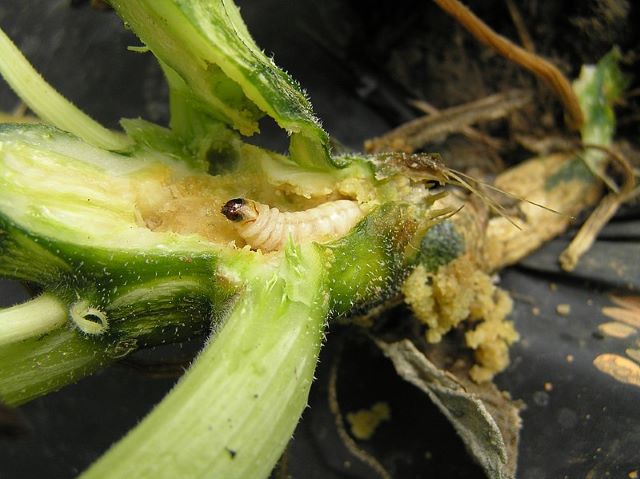
Another common squash pest that could be eating your zucchini is squash vine borers. They are a type of moth larva known for their destructive impact on zucchinis.
Squash vine borers, in their adult form, look like clearwing moths. They are typically orange-red and black with clear wings, which give them their name. These moths have a distinct appearance, resembling a wasp more than a typical moth.
However, it is the larvae that inflict damage on your zucchini. The larvae are caterpillar-like and have cream-colored bodies with brown heads. They can grow up to an inch in length. When they burrow into the stems of zucchini plants, their presence is often indicated by frass, which is sawdust-like excrement, and entry holes near the base of the stems.
Squash vine borers burrow into the stems of zucchini plants, where they feed on the plant’s internal tissues. This feeding disrupts the flow of water and nutrients, causing wilting, plant decline, and eventual death if left unmanaged. Infestations can lead to a loss of zucchini fruit production.
How to Get Rid of Squash Vine Borers from Zucchini Plants
Getting rid of squash vine borers is not an easy task. If you think your plant is being attacked by squash vine borers, the best way to deal with this is to carefully cut a small lengthwise slit in the stem. Upon spotting the larvae, gently extract them using a blade. After their removal, cover the slits with damp soil. It sounds drastic but this method is effective.
Prevention is key with squash vine borers, so it is best to protect your plants with floating row covers which will need to be removed for flower pollination.
To deter them, you can sprinkle diatomaceous earth around the base of the zucchini plant and use insecticidal soap on any eggs you might spot on the leaves.
9. Leafminers Eating Zucchini Plants
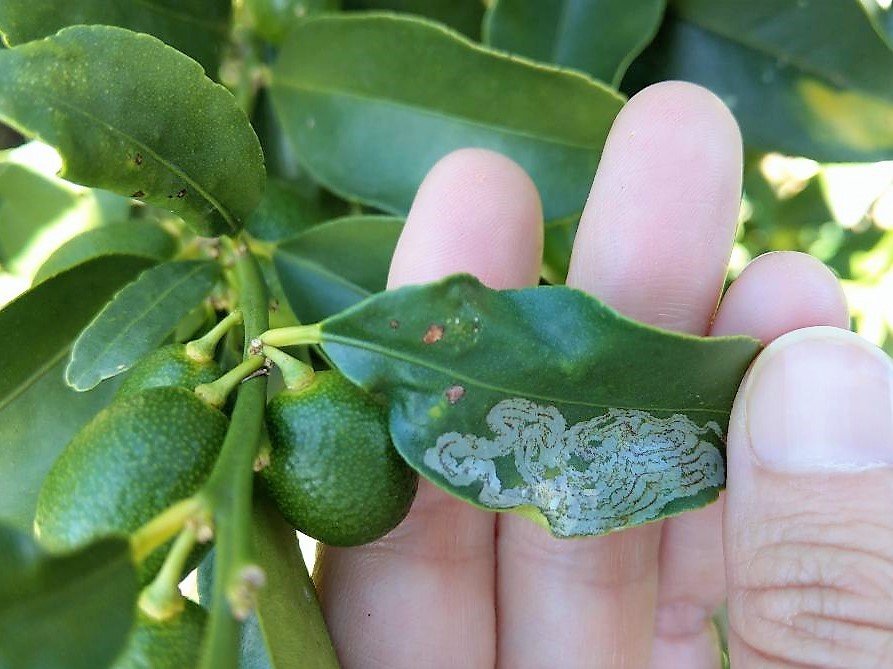
Leafminers are prevalent garden pests and are the larvae of different species of flies. The adult female fly deposits her eggs inside your zucchini’s leaves. These tiny insects eat your plant from the inside, munching on the tissue inside your zucchini’s leaves.
They get their name from the winding yellowish/white pathways or mines they leave on your plant’s leaves. In addition to the distinctive tunnels on your zucchini plant’s leaves, you will also notice white marks.
How to Get Rid of Leafminers from Zucchini Plants
The first thing to do when you spot the distinctive mines on your zucchini leaves is to remove them. Next, you will need to spray your plants with neem oil, although this will not solve your problem right away. Neem oil simply disrupts the lifecycle of leafminers, eradicating them slowly.
10. Thrips Are Eating Zucchini Plants
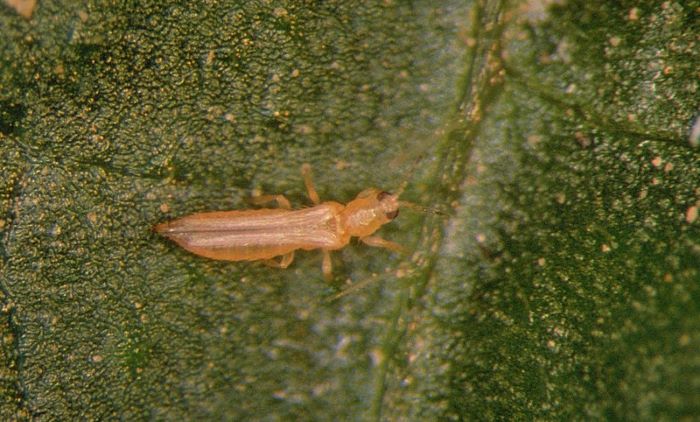
If you have noticed an odd, silvery sheen on your zucchini’s leaves, coupled with curled or twisted leaves, thrips are eating your zucchini. Thrips are tiny, slender insects barely visible to the naked eye and have elongated bodies. Thrips can vary in color, ranging from pale yellow or brown to black, depending on the species.
Thrips are piercing-sucking insects that feed on the tissue of your zucchini plant leaves. They suck the nutrients out of your plant, leaving it with that distinctive silver appearance. Eventually, the silver discoloration will turn brown, and your zucchini plant’s growth will be stunted.
How to Get Rid of Thrips from Zucchini Plants
Although they are tiny, an infestation of thrips is difficult to control and eradicate. If thrips are eating your zucchini, the first thing you need to do is remove any affected leaves. Once you have pruned your plants, you can dislodge the thrips by shaking your zucchini. You can catch the little insects in a cloth, or newspaper.
Thrips can also be hosed off your zucchini plants or if you have an old vacuum cleaner you can use it to gently remove the thrips.
Sticky traps around your zucchini plants are effective also with the use of neem oil sprayed on the plant.
11. Whiteflies Attacking Zucchini Plants
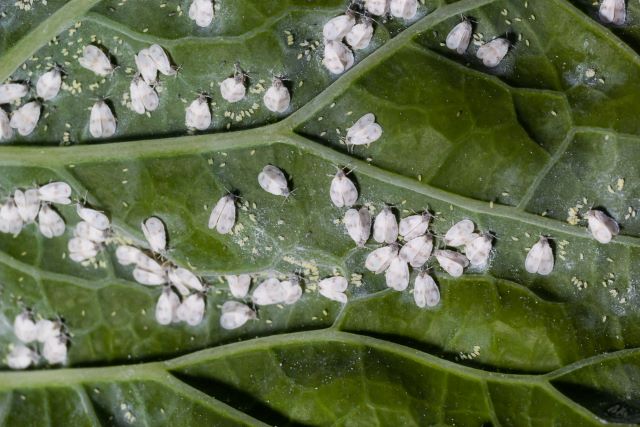
Whiteflies are tiny, winged insects that are called “whiteflies” due to their white coloration. These insects are common garden pests known for their rapid reproduction and ability to damage zucchini plants.
Whiteflies feed on your zucchini by sucking out your plant’s sap, similar to aphids, which they are a relative of. The adult whiteflies lay their eggs on the underside of your zucchini plant leaves, when these little pests hatch, they immediately start devouring your plant.
You will notice little holes in your zucchini plant’s leaves where the whiteflies have been feeding, along with yellowing. In addition, your zucchini will start to wilt.
How to Get Rid of Whiteflies from Zucchinis
You can get rid of whiteflies by planting herbs such as rosemary, basil, marigolds, nasturtiums or thyme close to your zucchini. As a rule of thumb, I always plant nasturtiums close to my zucchini after a particularly nasty whitefly problem.
For a bigger infestation of whiteflies you can use neem oil which will stop their breeding cycle.
Zucchini Plant Natural Predators and Beneficial Insects for Pest Control
The reality is, that pests in the garden are always going to be something you have to work with. And it’s not entirely a bad thing, pests have a role to play in nature.
Though understandably you do want to minimize the damage pests cause your zucchini plants so you have a great crop for your dinner! One way to do this is to work with nature by maintaining a balanced ecosystem in your garden. And you can do this by encouraging natural predators and beneficial insects into our garden.
Ladybugs are natural predators of aphids, and will happily eat them off your zucchini plant. By attracting ladybugs to your garden, you can keep aphid populations in check.
Similarly, parasitic wasps are invaluable allies in the garden. They lay their eggs on caterpillars, effectively parasitizing and reducing caterpillar populations. Should you be lucky enough to witness the parasitic wasp in action, you will see it’s a bit gruesome but incredible at the same time!
You can encourage natural predators by avoiding chemicals in your garden and by planting a diverse number of plants including flowers and herbs.
Zucchini Plant Pest Prevention Tips
Preventing zucchini pests from wreaking havoc on your plant is often more effective than dealing with an infestation afterward. So here are some prevention methods you can implement in your garden.
Companion planting with plants, like marigolds and nasturtiums, naturally repel zucchini pests. Plant them alongside your zucchinis as protective companions that also doubles as being pretty to look at.
Covering your zucchini plants with lightweight row covers can physically block pests from reaching your crops while still allowing sunlight and rain to nourish them. Just remember to uncover them to allow for pollination or you won’t achieve a zucchini crop.
Remove weeds and any garden debris where pests might hide or lay their eggs. This can help stop the pest cycle in its tracks.
Is It Really a Zucchini Pest Problem?
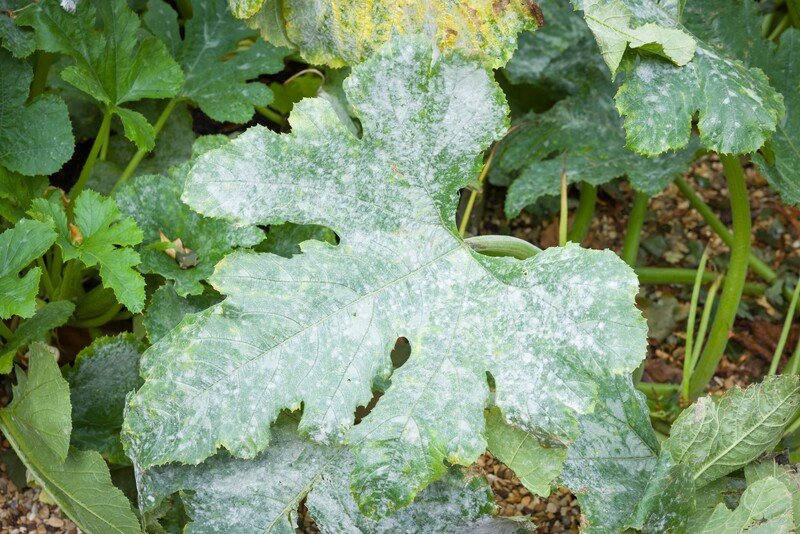
Sometimes, it’s not just zucchini-loving pests causing problems. Your zucchini plants may show signs of distress due to zucchini plant diseases or environmental factors.
Once a zucchini plant is weakened it will attract pests. So it’s important to work out if there is an underlying issue that caused a weakened zucchini plant now susceptible to pest attack.
Powdery mildew, for example, is a common fungal disease that affects zucchinis. It shows up on the zucchini plant as a white, powdery substance on leaves and stems. If you notice this, it’s a disease issue rather than a pest problem. Adequate air circulation and fungicidal treatments are necessary. Use this DIY milk spray to control powdery mildew. Ladybugs also help control powdery mildew.
Zucchini plants can also exhibit stress if they’re not receiving proper care. This can include inadequate watering or a lack of nutrients. Again, a zucchini plant that is stressed will attract pest infestations more easily.
Keep an eye on your zucchini plant health, be vigilant, and take action should you spot pests on your plant, and in no time you will be harvesting a bountiful crop of zucchini!
Related:
